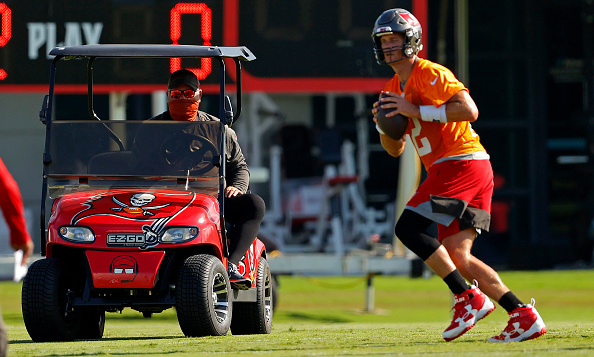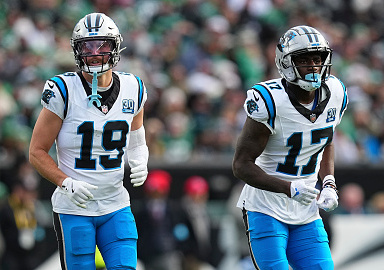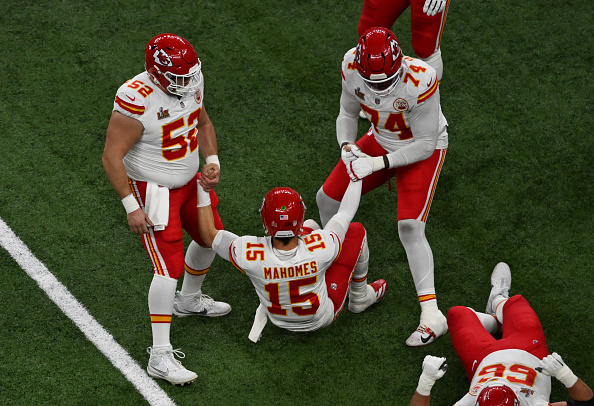A month from now, fans will either be celebrating or lamenting their team’s Week 1 performance from the 2020 NFL season. To say that the offseason has been an eventful one would be an understatement as the pandemic threw a wrench into the plans at every turn. Seemingly at the center of it all were the drawn-out negotiations between the NFL and NFLPA on the “COVID amendments,” the name attached to changes made to the collective bargaining agreement in order to ensure a 2020 campaign.
The following is a base rundown of the result of those negotiations, with some of the legal jargon put in friendlier terms. Some items you may already know (the opt-out deadline has passed), but also addressed are the salary and contract ramifications, COVID-19 restriction protocols, and testing and treatment protocols (including IR) for the virus during preseason camp and during the season itself.
After the final agreement was ratified, there were minimal changes to some of the language of the deal that may differ from the original, but the agreement remains the same. Should there be any changes to protocols (the testing is a fluid situation), those changes will be noted and updated below.
Training Camp
Camps have already begun around the league and the expectation was for everyone to arrive on time to camp unless they have already opted out and provided the team with written notice to that effect. Players that elect to not show up to camp on time without having notified their team are in violation of their contract if there was not some sort of agreement prior.
Salary Cap Shortfall in 2020
The NFL has taken steps to address the shortfall of revenues that would traditionally be collected, including ticket sales, in-venue advertising, concessions, parking, and numerous other opportunities for income.
Cuts include $17 million in player benefits for 2020, including:
- Second Career Savings Plan
- Annuity
- Severance pay
- Performance-based pay
- Tuition assistance
- Playoff bye week pay
- Pro Bowl pay (unless it is played)
The player benefits lost from the above in 2020 will be repaid to players via a new benefit plan after the 2023 season. This allows owners time to recoup some financial losses in the coming years before paying the money back. Essentially, it is a good-faith loan by the players.
2021 Salary Cap
The 2021 salary cap will not be lower than $175 million per team, but the official number has not been determined. For comparison, the 2020 salary cap is $198.2 million.
Tolling, Credited, and Accrued Seasons in 2020
If the 2020 season is unable to be completed, contracts of players on the roster and practice squad as of Week 1 will not toll if a week of games has been played. Once the first week of games are completed, the rostered players have effectively played in 2020. Even if the season is cancelled soon after, no additional years with their current team will be added to their contract, basically meaning if the league plays one week, the player has already lived up to that year of their contract from a service time standard. That said, owners are responsible for paying contracts on a games-played basis, but all guarantees would remain intact.
Players will earn one credited season (for the purpose of future pension and benefits) and one accrued season (for the purposes of free agency designation such as unrestricted versus restricted, etc.) for being on full pay for one regular-season game in 2020. The standard CBA would normally require three games and six games for credited and accrued seasons, respectively. Additionally, this offer is good for practice squad players, which is not normally the case.
Players that sign with a team after Week 1 will not receive these benefits and the standard 2020 CBA rules apply to them.
Opt-Out (Voluntary)
All players had the chance to elect to not play in the 2020 season but had to provide a declaration to that effect in writing to their team by 4:00 p.m. EDT on Aug. 6.
The contract of a player who has opted out will be tolled (“frozen”) and an additional year will be added to their contract. For example, if a player is signed through 2023 but decides to opt out, he is now signed through 2024, as he is not playing this season.
Players who opt out will not be granted a credited or accrued season since they did not play. They are not eligible for those designations even if the season is canceled. They have elected to take a year off in return for one additional year of service time to the team.
Voluntary opt-out players will receive a $150,000 stipend, which is treated like a salary advance from their contract.
Players cannot revoke their opt-out. Once the paperwork is filed, it is done.
Opt-Out (High Risk)
If a player would like to opt out due to being at a higher risk of being susceptible to complications from COVID-19, they must also submit it in writing to the team. It is not mandatory that a player opt out for this reason, but the option is available.
In order to qualify as high risk, a player must have one of the following ailments already documented in their medical files:
- Cancer
- Chronic kidney disease
- Chronic Obstructive Pulmonary Disease (COPD)
- Weakened immune system from organ transplant
- Serious heart conditions such as heart failure, coronary artery disease, cardiomyopathies
- Sickle cell disease
- Type 2 diabetes mellitus
- Asthma
- Cerebrovascular disease
- Cystic fibrosis
- Hypertension/high blood pressure
- Weakened immune system from blood or bone marrow transplants, immune deficiencies, HIV, corticosteroids, other immune-weakening meds
- Neurologic conditions
- Liver disease
- Pulmonary fibrosis
High risk players receive a stipend of $350,000 that will not count as a salary advance but will still count against the cap. The contract will fully toll to the following season, adding an additional year of team control to the end of the contract.
Players cannot revoke their opt-out. Once the paperwork is filed, it is done.
If a player or cohabitant is later diagnosed with any of the above ailments during the season, or in the case of a medical or family emergency, in some circumstances, the choice to opt out later would be available if terms are agreed upon by both sides.
High Risk Cohabitant
If a player participating in the 2020 season has a high-risk cohabitant (a person having a diagnosis of any of the high-risk factors), the team will offer separate housing for that player upon request. This will come with no financial obligation by the player. The deadline for such request is unknown.
Canceled Season Stipends
- If the season is fully canceled during training camp and before roster cutdowns:
Players on the roster or practice squad who earned a credited season in 2019 or draft picks in 2020 are given a $250,000 stipend, NFL player health insurance, and keep any contract money or bonuses they have already earned to that point.
Players on the roster or practice squad without a credited season in 2019 and undrafted players in 2020 are given a $50,000 stipend.
In both cases, no games have been played so the contracts all freeze (including salaries) and begin again in 2021.
- If the season is canceled during training camp and after roster cutdowns:
Players on the main roster will be given a $300,000 stipend and NFL player health insurance.
Players on the practice squad will be given a $100,000 stipend and NFL player health insurance.
Contract Guarantee Protection
If there is a cancellation or suspension of the 2020 season after it has already begun, players will be due their salary for games played (along with the stipend) with the remaining unpaid guarantees rolling over to 2021 or beyond. There is also room for negotiation between the teams and individual players in the case that a different agreement or contract amendment be proposed.
Any player that is terminated by his team after the season has begun is still due the entirety of his 2020 contract.
The only caveat to the payment of 2020 salaries relates to what sort of guarantees are written into his contract. Examples of these are skill or injury guarantees which are partial or “unprotected” and vary from player to player. If there is a reason the player cannot collect an unprotected portion of his salary, it will roll over via salary protection to the next year where it is applicable. For example, if a player already has a $5 million injury guarantee in his contract in 2020 and 2021 but not in 2022, that $5 million guarantee will apply to 2022.
There is a lot of exceptionally fine print in this section, but the main takeaway is this: one way or another, the players will be paid the full amount of their contract eventually. That said, in 2020, they are paid by the number of games played before cancellation and are due all bonuses they have already earned. At no time would any player be subject to returning funds back to the team.
Performance Bonus Adjustments
If the season is canceled but a player has still managed to achieve a performance bonus from their contract, they earn the full value of that bonus.
For any bonuses unearned because of a shortened season, the league will calculate what the pro-rata target would have be to earn the bonus and it will be paid out pro-rata as well. For instance, if a player needed one touchdown in every game (16 total) but the season ended after Week 8, he only would have needed eight touchdowns to earn the bonus (50 percent of 16 touchdowns equals eight touchdowns, etc.). Likewise, the amount of the bonus would also be 50 percent of the original amount.
Termination Pay
Any player qualifying for termination pay in the original CBA is still eligible in 2020 but will only be paid for the number of weeks completed by the league this season.
Football-Related Injury
Players diagnosed with COVID-19 after originally testing negative twice upon entry (meaning they likely contracted it while with the team) will have it treated as a football-related injury and are due all benefits of that designation listed in the original CBA and NFL Player Contract.
Teams are not allowed to comment on any player’s medical status aside from saying that they have been placed on the COVID IR, which can mean the player had symptoms that could be related, was exposed to someone who was later diagnosed, or tested positive themselves during routine testing. Being placed on COVID IR does not automatically mean a positive test.
The NFL or individual teams can challenge the designation of a football-related injury if they can prove that the player likely contracted COVID-19 through engaging in “high-risk conduct.”
Some examples of this include:
- Attending indoor nightclubs containing more than 10 people
- Attending an indoor bar (full-service restaurant is okay) containing more than 10 people (picking up food to-go from a bar is allowed)
- Attending house parties where there are more than 15 people
- Indoor concerts or entertainment venues
- Attending alternate sporting events, unless the player is in a separate area (owner’s box, etc.) and there are no more than 10 people
- Attending any event prohibited by state or local government because of COVID-19
In all cases, including those not listed here, even if attendance is allowed, players must adhere to practicing social distancing and wearing masks in public.
Teams may discipline players for “conduct detrimental to the team” for violating the above rules. The NFL also reserves the right to levy fines of up to $50,000 for violations, whether a player tests positive after this activity or not.
COVID-19 Related Testing and Protocols
Roger Goodell released this statement upon agreement to the “COVID Amendments” on July 24 regarding the protocols to be utilized during the 2020 season:
We have worked collaboratively to develop a comprehensive set of protocols designed to minimize risk for fans, players, and club and league personnel. These plans have been guided by the medical directors of the NFL and the NFLPA and have been reviewed and endorsed by independent medical and public health experts, including the CDC, and many state and local public health officials.
— NFL commissioner Roger Goodell
Some of the more intricate details of the protocols have yet to be released, but there are already some being used as players have reported to training camp.
Upon arrival every day, players are to have their temperature taken and answer a few questions, such as whether they have had symptoms, a fever, been exposed to someone else who is infected or traveled out of the country.
Players, coaches, and all staff that interact with them are subject to daily COVID-19 testing through at least Sept. 5. After that time, if the rate of positive tests drops below five percent, testing will be staggered to every other day. If the rate of positive cases again rises above five percent, the team will resume daily tests.
Everyone is still expected to wear masks and socially distance whenever possible when not on the field. This is a very new and fluid situation, so it will take time and repetition to adjust to these requirements, though the daily testing provides some peace of mind. The NFL has also attempted to drastically shorten the test turnaround time so that what happened in baseball does not happen in football practice. Of course, it is not all foolproof as results are still not instant and the chances of a false negative test still exist particularly in the virus’ incubation period.
Teams have also added tracking devices that all players, coaches, and staff will wear in their facilities. These devices can show after practice whether players are not mindful of keeping the appropriate distance from one another when not on the field. The devices also identify one another so that if someone tests positive, the team can go back and see who else might be susceptible based on how long they interacted with the infected player. These devices are worn as a wristband by players and turned in after each practice to be sterilized for the next day.
The FDA has recently approved a saliva-based (no nasal swab) test that was backed by the NBA. While it is unlikely to be used as the main form of testing, the NFL could look into adopting it as a quick-turnaround companion test to weed out false positives, though no official announcement has been made yet as to whether the NFL will pursue the use of such a test.
COVID Injured Reserve
Again, this is a fluid situation and tweaks are expected. The full details are not immediately known as the testing protocols were part of a separate agreement from the “COVID Amendments,” but here is some info that can be gleaned from numerous reports surrounding the COVID IR.
With regards to a possible false-positive test, if a player tests positive and has no symptoms and no history related to the virus, that player can take two more tests within 24 hours. If both tests are negative, the player can immediately report to the team without missing more than a day.
A player self-reporting flu-like symptoms who tests negative on their first test is unlikely to miss more than the waiting period to get the results back (within 24 hours).
A player who is symptomatic and tests positive is going to miss time. They cannot attempt negative tests until the symptoms are gone (which will usually take several days) and then still must test negative two times in a row with the tests spaced apart by 24 hours. This process alone will likely take nearly 10 days, and the NFL will have several physical tests a player must pass as a “ramp-up” before being allowed to rejoin the team. Symptomatic players can expect to miss two or more games depending on how quickly the symptoms subside.
In all three cases, the team may place the player on the COVID IR in order to bring in another player to practice. To aid in the inevitable coming and going on the IR, practice squads have been increased to 16 players, and teams will be able to designate a specific number of veterans on those squads as unable to be signed by another team.
At this point, there are no reported plans in place for alternative ways to complete the season, and there are unlikely to be. In order to enact options such as a bubble system, the league would have to write up a completely new agreement (agreed to by the league and NFLPA) and given the amount of time this one took, that seems unlikely.
Additionally, playing multiple games on one field is nearly impossible and air travel still would not be eliminated, meaning several teams in one stadium in one day which would multiply the chance of contamination exponentially. With the college football season in doubt, however, it is possible that the NFL could explore moving some games to Saturdays.
The NFL has had a chance to watch baseball closely and try to predict what the complications will be before they appear. They plan to play the 2020 season to its completion, and they have a lot at stake to make sure that they do.
Bookmark this page to check for updates leading up to—and following—the opening kick in Week 1.
Image credit:







